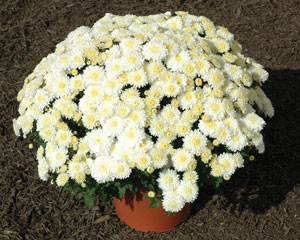6/23/2011
Growing Great Garden Mums
Mark Smith

By following a few simple steps and paying attention to the details, you can be on your way to growing great garden mums.
Cultural Tips
To get plants off to the best start, stick unrooted cuttings as soon as they arrive. To help reduce propagation time, use bottom heat to keep media temperature above 72F (22C) and do not over mist. Apply liquid feed during propagation, as well. Use night interruption lighting during propagation to help reduce premature budding.
Plant rooted cuttings as soon as possible after propagation or once the cuttings are delivered. Start a constant liquid-feed program when the cuttings are watered in and continue the constant liquid-feed program for the first half to two-thirds of the crop. Mums are heavy feeders so be sure to have enough feed in the pot for early growth and plan to re-feed pots after rain even though they’re still wet.
Although Florel is not required to grow good garden mums, some growers like to use it early in the crop as insurance against premature budding. If using Florel, start applications early for best results (during propagation and/or a couple days after transplant). Florel is less effective on shoots that have already initiated buds. Repeat applications every two weeks until early July for natural-season crops or eight weeks before ship on blackcloth crops. Be sure not to spray Florel on stressed cuttings.
Keep cuttings actively growing, especially during the first five weeks of the crop. Check the injector and irrigation system in the finishing area before the plants are moved in to be sure there are no delays in getting feed and water to the plants at the start of the crop. Transplant rooted cuttings on time to avoid root-bound cells or dry out in the trays; this makes cuttings hard. Nitrogen in the ammonium form is great for starting mums to encourage shoot growth. Night temperatures below 60F (15C) can cause garden mums to initiate flower buds, so plan to plant natural crops in late June, instead of late May, to take advantage of better temperatures and photoperiod. Do not allow the pots to dry out, as this will reduce plant size.
Drip irrigation is a great way to grow a garden mum. A drip system can be set up inexpensively and will reduce water and fertilizer waste versus overhead irrigation. A drip system will also irrigate a larger area of pots since the output per pot is lower and a drip system irrigates more uniformly even on a windy day. This can help prevent dry-out stress between irrigations and reduce crop setbacks and damage.
Garden mums set terminal buds easily and it’s not uncommon for most growers to see small buds early in the crop. Many of the varieties available today are so free-branching that lateral shoots will emerge before a pinch is given and therefore may seem like budded cuttings. Maintain moisture and fertilizer in the pot and the plants will continue to grow and fill out.
Garden mum growing is as easy as planting the cuttings and providing water and feed. As long as you pay attention to a few details, the plants will practically grow themselves.
GT
Note: These suggestions are only guidelines and may have to be altered to meet individual growers’ needs. Check all chemical labels to verify registration for use in your region. Always read and follow label instructions before buying or using Syngenta products. The instructions contain important conditions of sale, including limitations of warranty and remedy.
Mark Smith is a Technical Service Representative with Syngenta Flowers. In addition to his breeding research, Mark also assists growers in the field. He holds a B.S. and M.S. in Horticulture from the University of Connecticut. Contact Mark at mark.A.smith@syngenta.com.